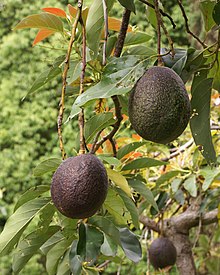Persea americana
| Avocado Temporal range: 15–0 Ma Middle Miocene – Recent |
|
|---|---|
 |
|
| Avocado fruit and foliage, Réunion island | |
 |
|
| Scientific classification | |
| Kingdom: | Plantae |
| (unranked): | Angiosperms |
| (unranked): | Magnoliids |
| Order: | Laurales |
| Family: | Lauraceae |
| Genus: | Persea |
| Species: | P. americana |
| Binomial name | |
|
Persea americana Mill. |
|
| Synonyms | |
|
|
| Nutritional value per 100 g (3.5 oz) | |
|---|---|
| Energy | 670 kJ (160 kcal) |
|
8.53 g
|
|
| Sugars | 0.66 g |
| Dietary fiber | 6.7 g |
|
14.66 g
|
|
| Saturated | 2.13 g |
| Monounsaturated | 9.80 g |
| Polyunsaturated | 1.82 g |
|
2 g
|
|
| Vitamins | |
| Vitamin A equiv. |
(1%)
7 μg
(1%)
62 μg271 μg
|
| Thiamine (B1) |
(6%)
0.067 mg |
| Riboflavin (B2) |
(11%)
0.13 mg |
| Niacin (B3) |
(12%)
1.738 mg |
| Pantothenic acid (B5) |
(28%)
1.389 mg |
| Vitamin B6 |
(20%)
0.257 mg |
| Folate (B9) |
(20%)
81 μg |
| Vitamin C |
(12%)
10 mg |
| Vitamin E |
(14%)
2.07 mg |
| Vitamin K |
(20%)
21 μg |
| Minerals | |
| Calcium |
(1%)
12 mg |
| Iron |
(4%)
0.55 mg |
| Magnesium |
(8%)
29 mg |
| Manganese |
(7%)
0.142 mg |
| Phosphorus |
(7%)
52 mg |
| Potassium |
(10%)
485 mg |
| Sodium |
(0%)
7 mg |
| Zinc |
(7%)
0.64 mg |
| Other constituents | |
| Water | 73.23 g |
| Fluoride | 7 µg |
| Beta-sitosterol | 76 mg |
|
|
|
|
|
| Percentages are roughly approximated using US recommendations for adults. Source: USDA Nutrient Database |
|
The avocado (Persea americana) is a tree that is native to South Central Mexico,classified as a member of the flowering plant family Lauraceae.Avocado (also alligator pear) also refers to the tree's fruit, which is botanically a large berry containing a single seed.
Avocados are commercially valuable and are cultivated in tropical and Mediterranean climates throughout the world. They have a green-skinned, fleshy body that may be pear-shaped, egg-shaped, or spherical. Commercially, they ripen after harvesting. Avocado trees are partially self-pollinating and are often propagated through grafting to maintain a predictable quality and quantity of the fruit.
Persea americana, or the avocado, is believed to have originated in the state of Puebla, Mexico, though fossil evidence suggests similar species were much more widespread millions of years ago, occurring as far north as California when the climate of that region was more hospitable to them.
The native, undomesticated variety is known as a criollo, and is small, with dark black skin, and contains a large seed. It probably coevolved with extinct megafauna. The oldest evidence of avocado use was found in a cave located in Coxcatlán, Puebla, Mexico, that dates to around 10,000 BC. The avocado tree also has a long history of cultivation in Central and South America, likely beginning as early as 5,000 BC. A water jar shaped like an avocado, dating to AD 900, was discovered in the pre-Incan city of Chan Chan.
The earliest known written account of the avocado in Europe is that of Martín Fernández de Enciso (circa 1470–1528) in 1519 in his book, Suma De Geographia Que Trata De Todas Las Partidas Y Provincias Del Mundo. The first written record in English of the use of the word 'avocado' was by Hans Sloane in a 1696 index of Jamaican plants. The plant was introduced to Indonesia in 1750, Brazil in 1809, South Africa and Australia in the late 19th century, and the Levant in 1908.
...
Wikipedia
